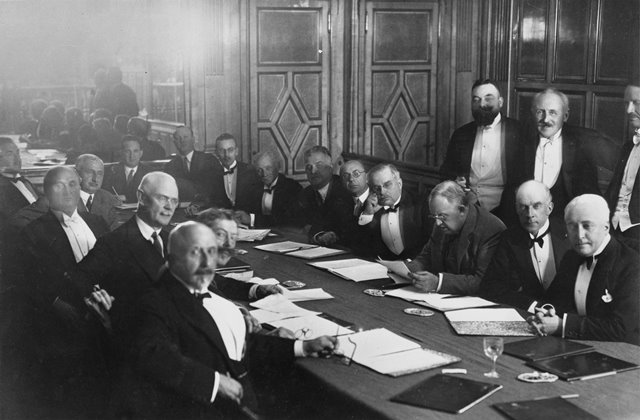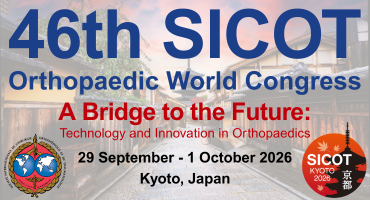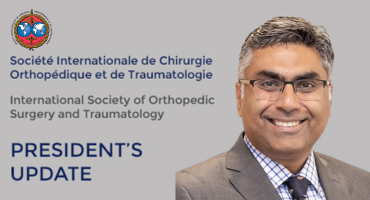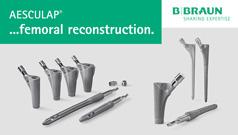
The founders of SICOT, 10 October 1929, Hotel Crillon in Paris, France
The known history of the origins of SICOT
by Prof Charles Sorbie, SICOT President 1996-1999
Innovations and original ideas may seem to come from groups or a committee but, in fact, they are usually generated in the imagination of one individual. We cannot be absolutely certain in whose bright mind the idea of SICOT first formed but it was most probably Vittorio Putti or Robert Lovett with early interest on the part of Hans Spitzy. There is scarce written evidence of the origins of SICOT and for what there is we are indebted to Calogero Casuccio, a former President of SICOT, who obtained information from the letters of Vittorio Putti held at the Instituto Rizzoli in Bologna.
The first reference relating to an international orthopaedic association, which eventually became SICOT, is found in a letter written by Robert William Lovett of Harvard University in Boston, U.S.A. Lovett wrote on November 25, 1913, that he had found enthusiastic support among his American colleagues for the formation of an international society of orthopaedic surgery. His letter was sent simultaneously to Professors Hans Spitzy of Vienna and Vittorio Putti of Bologna. It is clear from its content that he had discussed the idea with both Putti and Spitzy and they were both receptive. Lovett was a member of the American Orthopaedic Association, the oldest of all orthopaedic associations (founded in 1887). He was, therefore, quite familiar with a national society over the 36 years prior to his international reach. Several international societies had already been formed for dermatologists, otologists, genito-urinary surgeons and surgeons in general. There may have been others of which he was unaware.
During a talk at the 1936 Congress, Putti implied that he was the first promoter of the Society and said his interests were in improving orthopaedic surgery throughout the world by means of an international society.
Vittorio Putti was the Congress President in 1936 when it took place partly in Bologna and partly in Rome. He said in this opening address:
“I imagine this is the way you have chosen to show me your appreciation for the success of this Society which I have been the first and the most convinced promoter of. In this regard, let me point out something which may be of some relevance in the history of our Society.
Going back to 1913, in the course of a conversation I had in London with two eminent colleagues, now both deceased, Robert Lovett from Boston and Robert Jones from Liverpool, I suggested the timeliness, in order to contribute to a more rapid progress and a wider spreading of orthopaedic studies, of creating a society that would bring together all those devoted to orthopaedics throughout the world. The proposal was consented to with keen interest and a scheme of statutes was already being prepared when the world war broke out and interrupted all our plans.
The idea was seriously taken up again in 1923, in the course of a second meeting I had in Boston with Lovett and Jones, but even that time it had to be set aside because of Lovett’s unexpected death.
Convinced as I was of the rightness of the cause, I was but waiting for a new occasion to resume the design. The occasion did occur in London in 1929 when the American Society and the British Society of Orthopaedics met at a joint congress presided by Albee. I then expounded the whole idea to Albee, and it was a special merit of the rapid and strong action undertaken by this eminent colleague from New York if, within a few months, the foundations of the Society were laid and the first Congress could be summoned in Paris on October 2, 1930”.
There is no doubt, however, from the tone of Lovett’s letter, that he had discussed an international society with Hans Spitzy and Vittorio Putti prior to November 1913. His long letter contained a list of “statutes” which he gleaned from other international societies and, in particular, the International Society of Surgeons. He went on to suggest that the American Orthopaedic Association President, Secretary and a member, plus the President of the Orthopaedic Section of the American Medical Association and two representatives from western orthopaedic societies, be founding members.
Lovett outlined the structure of a “review” or a “journal” to be called “The International Journal of Orthopaedic Surgery”. He considered the journal to be an essential part of the society. It is remarkable that he was concerned that the members of the proposed society should have some clear benefits from being members and not simply the prestige of belonging.
He was keen to meet with Spitzy and Putti in Europe to establish the international society.
Hans Spitzy asked for and received the backing of the German Society of Orthopaedic Surgery.
Putti responded (July 13, 1914) by suggesting that the three of them meet that summer of 1914 in Courmayeur on the eastern slopes of Monte Bianco (Mont Blanc).
All plans for the International Society were suspended during the First World War and until 1923, when Lovett, Putti and Sir Robert Jones met in Boston. At that time, they attempted to revive the plans but unfortunately the following year, on July 2, 1924, Robert Lovett died in England, actually in the home of Sir Robert Jones.
Although we have little direct evidence for it, another name emerged on January 22, 1929, in the gestation of the International Society. That is the name of Fred H. Albee. (...) It seems that Fred Albee had grasped the importance of reviving the idea of an international association some time before 1929. The evidence for this is clear in the letter sent by Osgood to Harry Platt. Osgood must have been aware of Albee’s efforts to get the Society going and he tried to downplay them. Osgood wanted the Society to be formed by a group of men from Great Britain, America, Italy, France and Germany. He opined that such a group would carry weight and might at least propose a tentative organization. He was outraged by a magazine article on Fred Albee. He claimed that the article’s exaggerated popular style gave a false impression of Albee’s work, if it did not actually misrepresent facts. He implied that it had made Albee “notorious”. He was worried that Albee would take over the planning and control of the international society. (...) The combined meeting of the British and the American Orthopaedic Associations that took place in London during early July 1929 was attended by Albee, as its Chairman, and Putti. They were undoubtedly the movers and shakers when the meeting came to consider an international association. They got together with Sir Robert Jones of England, Professor Murk Jansen of Holland and Joel Goldthwaite of the United States. That small group unanimously agreed that the international association should be established. When the meeting was over, Harry Platt wrote on July 13, 1929, to Osgood that “our Fred” conducted his share of the meeting with modesty and distinction. He suggested that the international association was a feasible idea provided it was initiated by Osgood but with Albee’s support.
One of the most important letters written that led to the formation of SICOT was penned on July 29, 1929. It was sent by Fred Albee to Harry Platt to be sent to a chosen number of surgeons to seek their interest in a new society. I quote, “Dear Dr___________, during the recent conjoint meeting of the British Orthopaedic Association and the American Orthopaedic Association held recently in London, the question of the advisability of founding an International Orthopaedic Association came up spontaneously and was discussed informally by a group including Sir Robert Jones of England, Professor Putti of Italy, Dr Murk Jansen of Holland and Dr Goldthwaite and myself from the United States. It was unanimously agreed that such an association should be organized. The suitable time and place for an organization meeting were also considered. Professor Putti suggested Paris as the most central place and October 10 as the earliest and most suitable date.
It is needless to emphasize the opportunity for cooperation and exchange of ideas between the various nationals, which such an organization would afford. The success of the meeting in London is a good augury for the success of the projected association. I am sure you are in favour of it, in a general way, and I hope that you can arrange to take an active share in its organization in Paris, at the Hotel Crillon, October 10.
I am hoping for an early and favourable reply”.
Still Platt and Osgood were cautious. Both were happy that nothing actually was determined about the international association at the meeting in London and both wanted to move slowly. Albee, for his part, wrote a very gracious letter on July 31, 1929, to Robert Osgood. He told him that in the previous year, i.e. 1928, Albee himself had contacted a number of people who were all keen on the idea of the international association. He also said “Professor Putti and I both agreed to send out letters to men whom we all agree should be written to and, before leaving the city for the weekend, gave the material to my secretary to be sent out. Hence, I was much gratified upon my return (to New York) to find your letter confirming the quite unanimous feeling in regard to an international orthopaedic association. I am very happy to know that you will help in every way possible and hope you will be able to be in Paris on October 10.”
Putti and Albee, between them, sent letters to 31 different “prominent” orthopaedic surgeons in a number of countries. Murk Jansen responded on August 13 saying: “I see that you are organizing the international association with the same promptness which characterizes everything you do. I should be quite willing to be present in Paris on October 10 for the furthering of the scheme”. Jansen suggested that Albee put together his proposals for the nature of the society, guidelines along which the association might be developed.
On August 16, 1929, Sir Robert Jones wrote to Fred Albee: “I see you are back again at work and full of the energy which has already astounded everybody. It seems to go on without diminution. As my cablegram says, of course, I am quite at one with you in regard to the congress”. He goes on to ask questions about whether membership should be confined to people who are devoted to orthopaedic work. He is very keen that Albee and Putti’s plans should be sent to the interested surgeons for study so that the meeting in Paris could be postponed. He says: “You know what it is to meet a crowd of Germans and Frenchmen who will talk eternally and delay conclusions”. Even Putti was surprised at the speed at which things were moving, however, Jones did say that he would attend the meeting in Paris on October 10.
There seems little doubt that Fred Albee was the engine that powered the formation of the Society. It was his energy that got others to share his enthusiasm for the Society and to fix a date for its inauguration, October 10, 1929, at the Hotel Crillon in Paris. London had been considered to be a suitable place for holding the inaugural meeting of the Society but, since there had been a meeting in London just a few months earlier, Paris seemed more appropriate.
Finally everybody including Robert Jones, Harry Platt and Robert Osgood were in agreement that the meeting should take place. At this time, Albee was 53 years old. He planned to visit London on his way to Paris to give him an opportunity to meet with the Executive Committee of the British Orthopaedic Association and present his ideas for the Society. It also meant that several of the English surgeons did not need to attend the Paris meeting but could give their proxy support to be carried by Albee as he met with the other founding members in Paris. The British surgeons also realized that if they tried to delay the formation of the International Society, they would be left out of it. A.S. Blundell Bankart represented the mood of the BOA, which was one of reluctance or, at best, grudging acceptance. Harry Platt, among others, did not, however, wish to appear completely negative. Sir Robert Jones modified a memorandum prepared by Bankart and with Putti and Sir Tom Fairbank threw in his support. The exchange of letters continued to the very last minute before the Society was founded.
In spite of a few negative points of view, the first meeting did take place in Paris at the Hotel Crillon on October 10, 1929. The group of founders who attended included: from Austria, Erlacher and Spitzy; from Belgium, Lorthioir, Delchef and Maffei; from Spain, San Ricart; from the United States, Albee, Baer and Meyerding; from France, Ombrédanne, Rocher, Sorrel and Nové-Josserand; from Great Britain, Fairbank; from Germany, Bielsalski; from Italy, Galeazzi and Putti; from Holland, Murk Jansen; from Romania, Frans Jiano; from Sweden, Haglund and Waldenstrom; from Switzerland, Machard; and from Czechoslovakia, Zahradnicek.
The first meeting went surprisingly well in spite of the fact that no one understood what other people were saying. The language problem was significant but Murk Jansen helped very much by translating French into English and English into French. The session began after dinner at approximately 10.00 p.m. Unfortunately and for no clear reason, Albee was 45 minutes late. Murk Jansen took over the chairmanship. Albee then arrived and assumed the chair. Jansen continued as secretary and interpreter. The British memorandum was handed to Albee to read out loud and translated into French by Murk Jansen. According to one chronicler, Thomas Fairbank, it was a bombshell and it had no supporters. Fairbank fortunately was able to say that it was only an opinion and a British suggestion to delay the formation of the Society.
After Albee, as chairman, read the opinion of the English surgeons, Putti made it very clear that everybody had come with the intention of forming an international society and that was what they were going to do. Discussions followed and established that a congress would be held every three years. It was agreed that the membership would be 100 to begin with. Spitzy said that the German Orthopaedic Society concurred with the plan to form the organisation and that he would act as its representative. He felt that the membership should not be nominated by the national orthopaedic or surgical societies but that a committee in each country should nominate appropriate individuals. He said that the nominating committees should be those present as charter members. Spitzy felt strongly that good and appropriate members were often not members of national societies. The statutes of constitution were based on those that existed in the International Surgical Society. Each statute was debated separately and voted on. It was agreed that the official languages would be German, French, English, Italian and Spanish; that all officers would be appointed to honorary positions without pay and that the triennial dues would be $10.00 or the equivalent. A committee, which consisted of Spitzy, Putti, Jansen, Fairbank and Ombrédanne, was appointed to study and define the bylaws. When the meeting was adjourned at 1.00 a.m., Murk Jansen, Hans Spitzy and Henry Meyerding went on talking until 2.00 a.m. going over a constitution and translating from German into English the writings of the International Surgical Society.
Founders of the Society
Fred Albee † (United States)
William Baer † (United States)
Jean Delchef † (Belgium)
Philip Erlacher † (Austria)
Sir Thomas Fairbanks † (United Kingdom)
Riccardo Galeazzi † (Italy)
Patrick Haglund † (Sweden)
Jean Jiano † (Romania)
Paul Lorthioir † (Belgium)
Alfred Machard † (Switzerland)
Adolphe Maffei † (Belgium)
Henry W. Meyerding † (United States)
Willem Murk Jansen † (Netherlands)
Louis Ombrédanne † (France)
Vittorio Putti † (Italy)
Louis Rocher † (France)
Ramon San Ricart † (Spain)
Etienne Sorrel † (France)
Hans Spitzy † (Austria)
Henning Waldenstrom † (Sweden)
Jan Zahradnicek † (Czechoslovakia)
Presidents of the Society
1929-1930 | Sir Robert Jones † (United Kingdom) |
1930-1933 | Willem Murk-Jansen † (Netherlands) |
1933-1948 | Louis Ombredanne † (France) |
1948-1954 | Sir Harry Platt † (United Kingdom) |
1954-1960 | Jean J. Delchef † (Belgium) |
1960-1963 | Bryan McFarland † (United Kingdom) |
1963-1966 | Matthias Hackenroch † (Germany) |
1966-1969 | Sten Friberg † (Sweden) |
1969-1972 | Robert Merle d’Aubigné † (France) |
1972-1975 | Floyd Jergesen † (United States) |
1975-1978 | Calogero Casuccio † (Italy) |
1978-1981 | Keti T. Dholakia † (India) |
1981-1984 | |
1984-1987 | |
1987-1990 | Sir Dennis Paterson † (Australia) |
1990-1993 | Leonardo Zamudio † (Mexico) |
1993-1996 | Takao Yamamuro (Japan) |
1996-1999 | |
1999-2002 | Rainer I.P. Kotz (Austria) |
2002-2005 | John C.Y. Leong (Hong Kong) |
2005-2008 | Chadwick F. Smith † (United States) |
2008-2011 | Cody Bünger (Denmark) |
2011-2014 | Maurice Hinsenkamp (Belgium) |
2014-2016 | Keith Luk (Hong Kong) |
2016-2018 | Shanmuganathan Rajasekaran (India) |
2018-2020 | John Dormans (United States) |
2020-2022 | Ashok Johari (India) |
2022-2024 | Philippe Hernigou (France) |

















